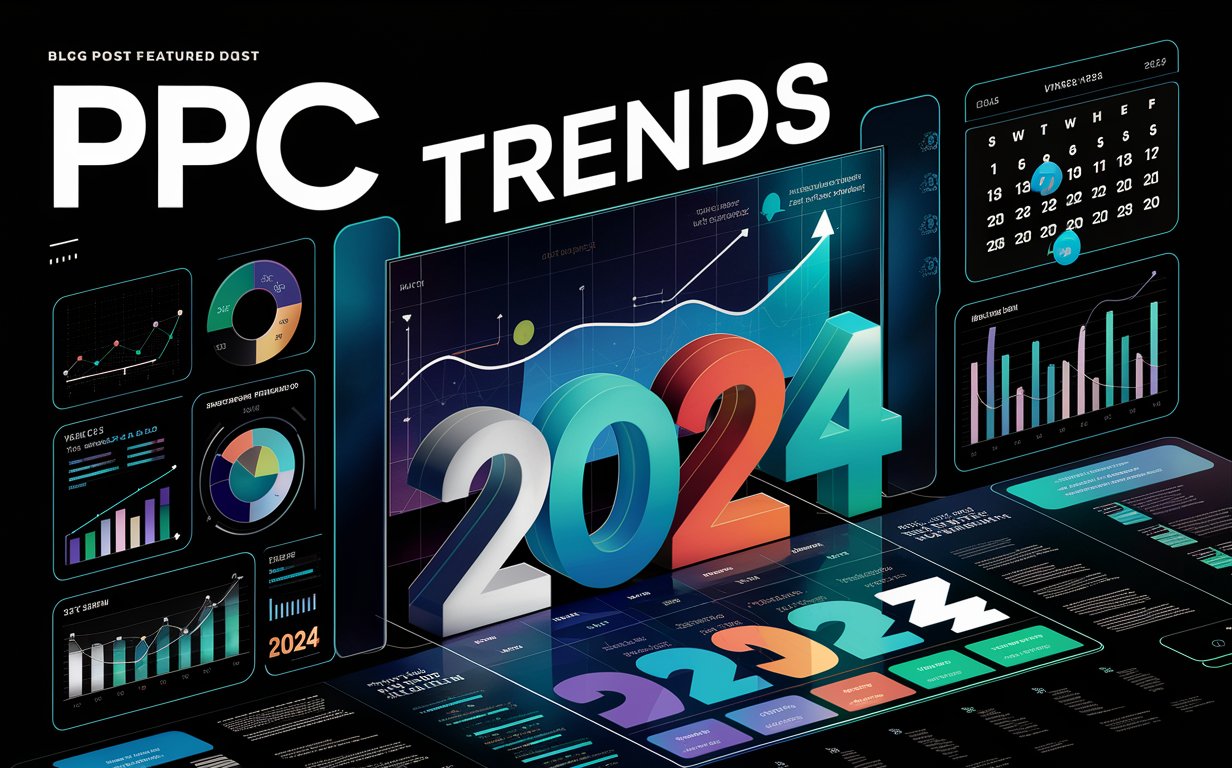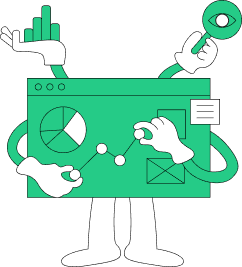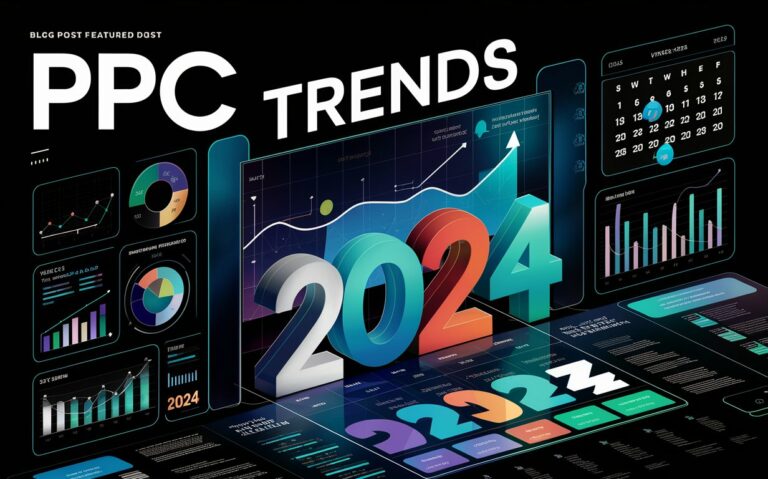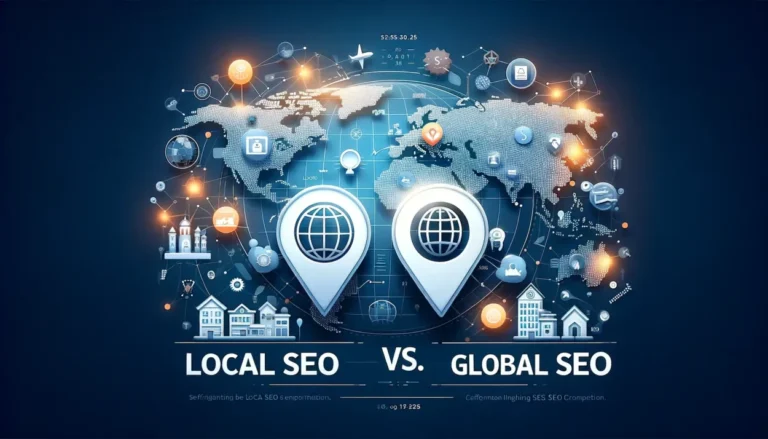As VentCube, we’re excited to guide you through the evolving landscape of pay-per-click advertising. With PPC trends constantly shifting, staying ahead is crucial for campaign success. Here’s a comprehensive look at what to expect in 2025, ensuring your campaigns leverage cutting-edge strategies for maximum impact.
Stay Ahead with These 20 PPC Trends for 2025
In 2025, the world of PPC will be more dynamic than ever. To help you navigate these changes, we’ve compiled 20 essential trends that will guide your strategy and ensure your campaigns remain effective and competitive. These trends cover everything from advanced automation to ethical advertising, each offering actionable insights and real-world examples to keep your PPC efforts on the cutting edge. Let’s dive into each trend and see how they can transform your digital marketing strategy.
1. Advanced Automation in PPC
Automation in PPC is revolutionizing the way campaigns are managed by simplifying complex tasks and enhancing efficiency. Advanced tools utilize AI to automate bidding, tailor ads based on user behavior, and optimize budget allocation across campaigns, making it essential for staying competitive. Many businesses are turning to PPC services to efficiently implement these tools and strategies, ensuring optimal results.
- Automate real-time bidding: Adjust bids automatically based on auction dynamics.
- Tailor ads with machine learning: Use AI to customize ad copy and targeting.
- Enhance efficiency: Reduce manual workload and focus on strategy.
- Optimize budget distribution: Ensure funds are allocated to the most effective campaigns.
- Improve campaign performance: Use data-driven insights to refine strategies continually.
Example: A retail company implemented automation tools for its PPC campaigns, which automatically adjusted bids during peak shopping hours based on competition and search volume, resulting in a 20% increase in ROI.
2. The Rise of Smart Bidding Strategies
Smart bidding in PPC uses machine learning algorithms to optimize your bids for each auction automatically. This approach tailors bids based on the likelihood of achieving predefined goals, making it a powerful tool for improving campaign results without constant manual oversight.
- Optimize for conversions: Automatically adjust bids to maximize conversions based on past performance.
- Target CPA (Cost Per Acquisition): Set bids to achieve an average CPA that you define.
- Enhanced CPC (Cost Per Click): Increase bids for clicks that seem more likely to lead to conversions.
- Seasonal trends adjustments: Adjust bids during high traffic periods like holidays.
- Reduce time spent on manual adjustments: Free up time for strategic planning rather than constant bid management.
Example: An online electronics store used smart bidding to target CPA during their back-to-school sale, resulting in a 30% decrease in CPA while increasing conversions by 50% compared to the previous period.
3. Voice Search Optimization
As voice-activated devices become more prevalent, optimizing PPC campaigns for voice search is crucial. Voice queries are typically longer and more conversational than text-based searches, requiring a nuanced approach to keyword strategies and content optimization.
- Use long-tail keywords: Incorporate more conversational phrases that match the natural speech patterns.
- Optimize for questions: Focus on question-based queries which are common in voice searches.
- Local SEO emphasis: Voice search is often used for local information, making local SEO tactics critical.
- Adapt content for direct answers: Structure content to provide clear, concise answers that voice assistants can easily interpret.
- Test and refine based on device: Differentiate strategies for Google Home, Amazon Alexa, etc.
Example: A local restaurant optimized their PPC ads for voice search by targeting phrases like “What’s the best pizza place near me?” This led to a 25% increase in local foot traffic from voice-activated device users.
4. Expanding Horizons with Amazon Advertising
Amazon Advertising has become a vital PPC platform due to its massive reach and the intent-driven audience it captures. Effective use of Amazon PPC not only increases product visibility but also drives sales by placing products directly in front of interested buyers.
- Utilize sponsored products: Boost visibility of specific products to targeted audiences.
- Leverage sponsored brands: Increase brand awareness through customized headline ads and logos.
- Explore sponsored display ads: Retarget visitors who viewed your products but didn’t purchase.
- Use Amazon’s vast data: Target ads based on rich shopping and buying behavior.
- Integrate with Amazon Storefronts: Direct traffic to a branded page on Amazon.
Example: A skincare brand used Amazon Advertising’s sponsored products to target customers searching for organic skincare solutions, resulting in a 40% uplift in sales within the first month of implementation.
5. Seamless PPC and SEO Integration
Integrating PPC and SEO strategies can create a cohesive digital marketing approach that leverages the strengths of both tactics. By aligning keywords and content strategies, marketers can improve visibility across search engines, driving both immediate and long-term results.
- Share keyword data: Use PPC keyword data to inform SEO content strategies.
- Align content creation: Develop content that supports both paid and organic search goals.
- Consistent messaging: Ensure that PPC ads and organic listings convey the same message.
- Combined reporting: Analyze PPC and SEO results together to get a holistic view of search performance.
- Leverage SERP coverage: Dominate search engine result pages by appearing in both paid and organic results.
Example: A travel agency aligned their SEO and PPC efforts around the keyword “luxury Caribbean vacations.” This dual strategy led to a 70% increase in total traffic and a 50% boost in booking conversions, as they dominated the search results for their targeted keywords.
6. Innovations in Video Advertising
Video advertising continues to evolve, with innovations in formats and platforms that enhance user engagement and conversion rates. Emphasizing the use of engaging, dynamic content can significantly increase the effectiveness of PPC campaigns, especially as consumer preferences shift towards more visual media consumption.
- Experiment with interactive elements: Include call-to-action buttons or interactive features in videos.
- Leverage 360-degree videos: Provide immersive experiences that allow viewers to control their perspective.
- Focus on mobile optimization: Ensure videos are formatted for mobile devices, which are increasingly the primary means of content consumption.
- Utilize platform-specific features: Tailor content to the unique features of platforms like YouTube, Facebook, or TikTok.
- Measure performance and iterate: Constantly analyze video performance metrics to refine and improve campaigns.
Example:A fitness apparel brand launched a series of interactive video ads on Instagram that allowed users to tap to see product details. This strategy led to a 45% increase in engagement and a 30% increase in click-through rates compared to their standard video ads.
7. Leveraging Ads Data Hub
Ads Data Hub provides advertisers with advanced data analysis capabilities, enabling them to measure and optimize their ad campaigns more effectively. This tool is crucial for marketers who need detailed insights across various Google platforms without compromising user privacy.
- Unified data analysis: Combine data from YouTube, Google Ads, and Display & Video 360.
- Privacy-centric: Analyze large sets of data while adhering to stringent privacy regulations.
- Cross-device measurement: Understand how your ads perform across different devices.
- Detailed attribution modeling: Gain insights into the customer journey and measure conversion paths.
- Advanced audience insights: Utilize advanced metrics to refine targeting strategies.
Example: An automotive company used Ads Data Hub to integrate and analyze cross-platform campaign data, identifying key customer pathways that led to test drives. The insights obtained allowed them to increase their conversion rate by 20% by reallocating budget to high-performing ads.
8. Social Media’s Role in PPC
Social media platforms offer unique opportunities for PPC campaigns due to their vast, engaged user bases and sophisticated targeting capabilities. Advertisers can tap into these networks to reach highly specific audiences, leveraging the platforms’ rich user data for enhanced targeting and conversion.
- Choose the right platform for your audience: Match your target demographic with the appropriate social network.
- Use native advertising features: Take advantage of unique ad formats specific to each platform.
- Engage with rich media content: Utilize images, videos, and interactive content to capture attention.
- Segment and target precisely: Use demographic, psychographic, and behavioral data to refine your audience.
- Monitor and respond quickly: Engage with comments and feedback to improve ad performance.
Example: A beauty brand used Facebook’s dynamic ads to target users who had visited their website but not purchased. By showing these users personalized ads based on the products they viewed, the brand saw a 35% increase in return on ad spend.
9. Addressing Data Privacy in PPC
As data privacy regulations like GDPR and CCPA become increasingly stringent, PPC advertisers must navigate these legal landscapes carefully to protect user privacy while still targeting effectively. Understanding and complying with these regulations not only protects your business from potential fines but also builds trust with your audience.
- Stay updated on privacy laws: Regularly review changes in data protection regulations.
- Implement privacy-first advertising strategies: Focus on transparency and user consent in all campaigns.
- Use privacy-compliant tracking methods: Adapt tracking methods to meet privacy standards without compromising on data quality.
- Educate your audience: Clearly communicate how their data will be used and secured.
- Audit and adjust regularly: Continuously evaluate and adjust your strategies to remain compliant.
Example: A digital marketing agency revamped its PPC strategies to align with the new GDPR guidelines, introducing clearer consent forms and privacy notices. This not only complied with new laws but also increased user trust, boosting click-through rates by 15%.
10. The Impact of CTV on PPC
Connected TV (CTV) advertising is emerging as a significant trend in PPC, offering a new avenue to reach audiences who are increasingly turning to streaming services for content. By integrating CTV into your PPC strategy, you can reach a broader audience in a more targeted and engaging environment.
- Target cord-cutters: Reach audiences who have moved away from traditional cable.
- Utilize advanced targeting options: Leverage detailed viewer data for precise ad targeting.
- Integrate with other digital campaigns: Create cohesive multi-platform strategies.
- Measure engagement and conversion: Track how CTV ads drive specific viewer actions.
- Explore interactive ad formats: Use CTV’s capabilities for engaging and interactive advertisements.
Example: An entertainment company used CTV ads to promote a new series launch. By targeting viewers who had shown interest in similar genres, they saw a 40% increase in engagement rates compared to their traditional TV ad campaigns.
11. Combating Click Fraud
Click fraud can drain PPC campaign budgets and skew performance metrics, making it crucial for advertisers to detect and prevent fraudulent activities. Utilizing advanced tools and strategies to identify suspicious activity helps protect your advertising investment and ensures the integrity of your campaign data.
- Implement automated detection tools: Use software that identifies and blocks fraudulent clicks.
- Monitor campaign traffic regularly: Keep an eye on unusual activity or spikes in traffic.
- Set up IP exclusions: Block IPs that repeatedly produce suspicious activity.
- Employ advanced analytics: Analyze patterns that may indicate fraud.
- Collaborate with platforms: Work with advertising platforms to address vulnerabilities.
Example: A tech company noticed irregular click patterns in their PPC reports. By using automated fraud detection tools, they identified and blocked the source of the fraudulent clicks, saving an estimated 20% of their monthly ad spend that was previously lost to click fraud.
12. Google Shopping for E-commerce Success
Google Shopping ads are a powerful tool for e-commerce businesses, enabling them to showcase their products directly in Google’s search results. Effective use of Google Shopping can significantly enhance visibility and drive sales by placing your products right where potential customers are already searching.
- Optimize product listings: Ensure product titles, descriptions, and images are clear and SEO-friendly.
- Use high-quality images: Attract more clicks with professional, appealing product images.
- Segment products strategically: Group products in ways that align with shopping behaviors.
- Implement dynamic remarketing: Target users who have viewed your products but haven’t made a purchase.
- Leverage competitive pricing: Keep pricing competitive to stand out in search results.
Example: An online apparel store optimized its Google Shopping campaigns by improving image quality and adjusting product titles. This led to a 50% increase in click-through rates and a 30% rise in conversion rates, significantly boosting overall sales.
13. Precision Audience Targeting
Advanced targeting strategies in PPC allow marketers to pinpoint their ideal audience segments more accurately than ever before. Utilizing data-driven insights to tailor ads can significantly enhance campaign relevance and effectiveness.
- Utilize layered targeting options: Combine demographic, geographic, and behavioral data to refine your audience.
- Leverage lookalike audiences: Expand reach by targeting new users who resemble your best customers.
- Incorporate psychographic segmentation: Target based on lifestyles, values, and interests.
- Use predictive analytics: Anticipate future behaviors based on past interactions.
- Continuously refine targeting: Use ongoing data feedback to improve targeting precision.
Example: A luxury watch brand used precision targeting to reach high-net-worth individuals interested in luxury goods. By using lookalike audiences based on their existing customers, they increased their return on ad spend by 40%.
14. Developing a Dynamic Remarketing Strategy
Remarketing is a crucial strategy in PPC that targets individuals who have previously interacted with your brand but did not convert. Dynamic remarketing takes this a step further by displaying personalized ads based on the specific products or services users viewed.
- Tailor ads based on user behavior: Customize the content of your ads based on past interactions.
- Use dynamic product ads: Automatically show users ads for products they have previously viewed.
- Segment remarketing lists: Create different lists for various types of interactions.
- Implement frequency capping: Avoid ad fatigue by limiting how often users see your ads.
- Test and optimize creatives: Continuously test different ad elements to find the most effective combinations.
Example: A home decor site implemented dynamic remarketing to target users who viewed but did not purchase specific furniture items. By showing these users targeted ads featuring the viewed products, they achieved a 35% uplift in sales.
15. Harnessing AI for PPC Optimization
Artificial intelligence is transforming PPC by automating complex decision-making processes, providing insights into consumer behavior, and optimizing ads for maximum effectiveness. AI can analyze vast amounts of data to offer predictions and recommendations that are far beyond human capabilities.
- Automate ad testing: Use AI to run continuous A/B testing on ad copy and visuals.
- Optimize bids in real time: Adjust bids automatically based on the likelihood of conversion.
- Personalize user experiences: Tailor ads and landing pages to individual preferences and behaviors.
- Predict customer behavior: Use AI to predict and act on future consumer trends.
- Enhance keyword management: Automate the discovery and optimization of new keywords.
Example: A digital marketing agency used AI-driven tools to optimize ad spend for a national retail chain, resulting in a 25% reduction in costs per acquisition and a 50% increase in conversions by targeting users more likely to buy.
16. The Relevance of Visual and AR-Driven Ads
As augmented reality (AR) and visual search technologies continue to develop, they offer unique opportunities for PPC campaigns. By incorporating these elements, advertisers can create more immersive and engaging experiences that resonate with users and drive higher conversion rates.
- Incorporate AR in ads: Use AR features to allow customers to visualize products in their own environment.
- Optimize for visual search: Ensure that images are high-quality and properly tagged for visual search engines.
- Create interactive content: Develop ads that allow users to interact with products in a meaningful way.
- Leverage platform capabilities: Utilize AR tools available on platforms like Snapchat and Instagram.
- Use data-driven insights: Analyze user interactions with visual content to refine strategies.
Example: A cosmetics brand used AR filters on Instagram that allowed users to virtually try on different shades of lipstick. This interactive ad format resulted in a 30% increase in engagement and a 20% increase in sales conversions.
17. Utilizing First-Party Data Effectively
First-party data has become increasingly valuable as third-party cookies are phased out due to privacy concerns. This data, collected directly from your customers, can be leveraged to create highly personalized and effective PPC campaigns.
- Collect data through direct interactions: Use customer interactions on your website, email sign-ups, and purchase history to gather valuable insights.
- Segment your audience: Create detailed customer segments based on behavior, demographics, and preferences.
- Personalize ad content: Tailor ads to individual users based on their past interactions with your brand.
- Increase retention rates: Use first-party data to improve customer loyalty by offering personalized promotions.
- Optimize remarketing campaigns: Leverage this data to create more targeted and effective remarketing efforts.
Example: An e-commerce site specializing in athletic wear used first-party data to segment its audience based on purchase history and browsing behavior. This allowed them to create personalized ad campaigns that led to a 40% increase in customer retention and a 25% boost in overall sales.
18. The Omnichannel Approach in PPC
An omnichannel PPC strategy ensures that your brand message is consistent across multiple platforms and devices, creating a seamless experience for your audience. This approach not only enhances brand visibility but also drives higher engagement and conversion rates.
- Integrate marketing efforts across channels: Coordinate PPC campaigns across search engines, social media, and display networks.
- Maintain consistent messaging: Ensure that your brand voice and message are uniform across all platforms.
- Use cross-channel analytics: Track customer interactions across different platforms to gain insights into their behavior.
- Optimize for device-specific experiences: Tailor your campaigns for mobile, desktop, and tablet users.
- Leverage retargeting: Use omnichannel strategies to retarget users across various platforms for improved conversion rates.
Example: A fashion retailer implemented an omnichannel PPC strategy by synchronizing their Google Ads, Facebook campaigns, and email marketing. This comprehensive approach resulted in a 50% increase in online conversions and a significant boost in in-store visits.
19. Ethical Advertising and PPC
As consumers become more socially conscious, ethical advertising is gaining importance in PPC campaigns. Brands that prioritize transparency, honesty, and sustainability in their advertising efforts are more likely to build trust and loyalty among their audiences.
- Promote honest messaging: Ensure all ads are truthful and avoid misleading claims.
- Focus on sustainability: Highlight eco-friendly practices and products in your ads.
- Respect user privacy: Be transparent about data collection and use practices.
- Support social causes: Align your brand with causes that resonate with your audience.
- Avoid exploitative tactics: Ensure your ads are respectful and non-manipulative.
Example: A company in the beauty industry launched a PPC campaign promoting its cruelty-free and vegan products. By aligning the campaign with the values of its target audience, the company saw a 60% increase in engagement and a significant improvement in brand sentiment.
20. Staying Agile in a Fast-Evolving Market
The digital advertising landscape is constantly changing, making agility a critical component of successful PPC management. By staying flexible and responsive to new trends and technologies, businesses can quickly adapt their strategies to maintain a competitive edge.
- Monitor industry trends: Stay informed about the latest developments in digital advertising.
- Be ready to pivot: Quickly adjust campaigns in response to market changes or emerging trends.
- Test and iterate: Continuously experiment with different strategies and optimize based on results.
- Invest in ongoing education: Ensure your team is up-to-date on the latest PPC tools and techniques.
- Foster a culture of innovation: Encourage creative thinking and experimentation within your marketing team.
Example: A travel agency stayed agile during the pandemic by rapidly shifting its PPC focus from international travel to local getaways and outdoor experiences. This quick pivot allowed them to maintain revenue streams despite global travel restrictions.
Expert Insights: Key Takeaways for Navigating PPC in 2025
As the digital marketing landscape rapidly evolves, it’s essential to stay informed about the latest PPC trends and strategies. To provide deeper insights into what to expect in 2025, we’ve gathered perspectives from PPC industry experts who are leading the way in PPC innovation. These insights will not only help you understand the trends we’ve outlined but also give you actionable advice on how to implement them effectively.
The Importance of Automation and AI
Industry leaders agree that automation and AI will continue to play a crucial role in PPC. According to Google’s Chief Economist Hal Varian, AI-driven tools can significantly optimize ad performance by analyzing vast datasets in real-time. This capability allows advertisers to make data-informed decisions faster, reducing costs and increasing conversion rates.
Leveraging First-Party Data
With the decline of third-party cookies, experts like Ginny Marvin, Ads Product Liaison at Google emphasize the need to pivot towards first-party data. Marvin highlights that brands that effectively use first-party data will see better targeting and more personalized ad experiences, leading to higher engagement and customer loyalty.
The Shift Toward Privacy-Centric Advertising
As noted by Brad Geddes, Co-Founder of Adalysis, privacy concerns are reshaping PPC strategies. Geddes advises businesses to prioritize transparency and user consent in their advertising efforts. By doing so, brands can build trust and ensure compliance with evolving regulations, ultimately enhancing ad performance.
The Rise of Video and Visual Search
Neal Schaffer, a recognized digital marketing strategist, points out that video and visual search will dominate PPC trends in 2025. He suggests that brands should focus on creating compelling visual content that resonates with audiences, particularly on mobile devices, to capture attention and drive conversions.
Adapting to Market Changes with Agility
Frederick Vallaeys, CEO of Optmyzr, stresses the importance of agility in PPC campaigns. Vallaeys notes that the ability to quickly adapt to market shifts, such as changes in consumer behavior or emerging platforms, will be key to staying competitive. He encourages brands to foster a culture of experimentation and continuous learning within their marketing teams.
Ready to Leverage These PPC Trends?
2025 is bringing exciting changes to PPC advertising, and staying ahead is key to maximizing your results. Whether you’re looking to integrate advanced automation, optimize your Google Ads, or embrace new trends like ethical advertising, VentCube is here to help.
Let’s work together to create a PPC strategy that boosts your ROI and keeps you ahead of the competition. Get in touch with VentCube today and start turning these trends into opportunities for your business.
Conclusion
As we look ahead to 2025, the landscape of PPC advertising continues to evolve, offering new opportunities and challenges. By staying informed and adaptable, businesses can harness these trends to drive better results, whether through advanced automation, enhanced audience targeting, or ethical advertising practices.
The key to success lies in not just understanding these trends but also in strategically implementing them to align with your business goals. By integrating these insights into your PPC campaigns, you can ensure that your advertising efforts are not only relevant and effective but also positioned for long-term success in an increasingly competitive market.
At VentCube, we’re committed to helping you navigate this dynamic environment. Let’s work together to create a PPC strategy that capitalizes on these trends, drives significant ROI, and sets the foundation for your success in 2025 and beyond.






